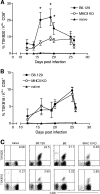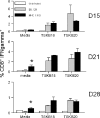Limited role for CD4+ T-cell help in the initial priming of Trypanosoma cruzi-specific CD8+ T cells
- PMID: 17043105
- PMCID: PMC1828400
- DOI: 10.1128/IAI.01245-06
Limited role for CD4+ T-cell help in the initial priming of Trypanosoma cruzi-specific CD8+ T cells
Abstract
Immune control of the protozoan parasite Trypanosoma cruzi requires the activation of both CD4+ and CD8+ T cells. We recently identified two T. cruzi trans-sialidase peptides that are targets of approximately 30% of all CD8+ T cells during acute T. cruzi infection in mice. To determine whether CD4+ T cells are required for generation of these dominant CD8+ T-cell responses, major histocompatibility complex class II (MHC II)-deficient mice were infected with the Brazil strain of T. cruzi and examined for the generation of antigen-specific CD8+ T cells. Strong trans-sialidase TSKB18- and TSKB20-specific CD8+ T-cell responses were generated in both the presence and the absence of CD4+ help. However, the magnitudes of the immunodominant TSKB20-specific CD8+ T-cell responses detectable using class I MHC-peptide tetramers were consistently lower in the blood and spleens of MHC II-deficient mice. Spleen cells from infected MHC II-deficient mice produced gamma interferon after in vitro stimulation with T. cruzi peptides at levels similar to those in wild-type mice, and MHC II-deficient mice displayed strong T. cruzi peptide-specific cytotoxic T-lymphocyte activity in vivo. Thus, primary CD8+ T-cell responses in experimental T. cruzi infection are generated in the absence of CD4+ T cells, providing further evidence that T. cruzi directly activates and licenses antigen-presenting cells. Nevertheless, unhelped CD8+ T cells in T. cruzi-infected mice fail to reach the frequencies achieved in the presence of CD4 T-cell help and are unable to prevent acute-phase death of these mice.
Figures




References
-
- Albareda, M. C., S. A. Laucella, M. G. Alvarez, A. H. Armenti, G. Bertochi, R. L. Tarleton, and M. Postan. 2006. Trypanosoma cruzi modulates the profile of memory CD8+ T cells in chronic Chagas' disease patients. Int. Immunol. 18:465-471. - PubMed
-
- Alba Soto, C. D., G. A. Mirkin, M. E. Solana, and S. M. Gonzalez Cappa. 2003. Trypanosoma cruzi infection modulates in vivo expression of major histocompatibility complex class II molecules on antigen-presenting cells and T-cell stimulatory activity of dendritic cells in a strain-dependent manner. Infect. Immun. 71:1194-1199. - PMC - PubMed
-
- Behrens, G., M. Li, C. M. Smith, G. T. Belz, J. Mintern, F. R. Carbone, and W. R. Heath. 2004. Helper T cells, dendritic cells and CTL immunity. Immunol. Cell Biol. 82:84-90. - PubMed
-
- Bennett, S. R. M., F. R. Carbone, F. Karamalis, R. A. Flavell, J. F. A. P. Miller, and W. R. Heath. 1998. Help for cytotoxic-T-cell responses is mediated by CD40 signalling. Nature 393:478-480. - PubMed
-
- Beuneu, H., Z. Garcia, and P. Bousso. 2006. Cutting edge: cognate CD4 help promotes recruitment of antigen-specific CD8 T cells around dendritic cells. J. Immunol. 177:1406-1410. - PubMed
Publication types
MeSH terms
Substances
Grants and funding
LinkOut - more resources
Full Text Sources
Other Literature Sources
Research Materials

